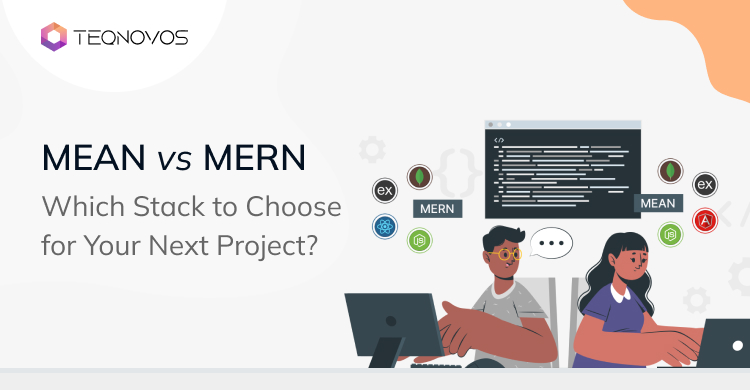MEAN vs MERN: Which Stack to Choose for Your Next Project?
MEAN and MERN are among the most popular stacks for web development. Both these stacks are suitable for developing a variety of web applications. Although MEAN and MERN stacks have some similarities, such as both allowing us to build web applications, they have several differences in terms of characteristics. Thus, each one of them is better suited for specific projects.
If you are planning to build a web application but are confused as to which among MEAN and MERN is the best for your project, this blog is for you. Here, we will discuss all the key differences between MEAN and MERN to help you decide which one is right for you.
So, let’s start with a quick overview of MEAN and MERN stacks.
What is MEAN Stack?
MEAN stack is a combination of four major technologies that facilitate the development of full-fledged web applications. These pivotal technologies consist of MongoDB, Express, Angular, and Node.js.
One notable thing about the MEAN stack is that all the technologies under it support JavaScript. In other words, a developer with knowledge of JavaScript programming language can use MEAN stack to develop both the front-end and the back-end of web apps.
Among the four technologies in the MEAN stack, developers utilize Angular to build the front end of web applications. On the other hand, Node.js and Express are for designing the back-end logic, while MongoDB acts as the database for storing and retrieving application data.
What is MERN Stack?
MERN stack is also a JavaScript-based web development stack. It comprises the same technologies as MEAN except for Angular, which is replaced by React. MERN stack utilizes React for front-end development. The introduction of React makes the MERN stack different from the MEAN stack.
Differences Between MEAN Stack and MERN Stack
MEAN vs. MERN is a hot topic among JavaScript developers as well as businesses willing to create dynamic and scalable web applications. As mentioned earlier, the utility of both stacks is the same, i.e., web application development. However, they have many differences that you need to understand to choose the right one for your project.
Let’s discuss the differences between MEAN and MERN based on different parameters:
MEAN vs MERN: Programming Language
JavaScript is the primary language for working with both MEAN and MERN stacks. However, when it comes to the MEAN stack, the knowledge of TypeScript is a plus. Angular supports both JavaScript and TypeScript programming languages. However, TypeScript is the recommended language to make the most of Angular for developing the front end of web applications.
Similarly, React makes use of JSX, which is an extension of the JavaScript language. The main use of JSX is to write HTML code directly in React. However, the use of JSX is optional but recommended to build better UI components.
MEAN vs MERN: Learning Curve and Implementation
Angular is a JavaScript framework that is difficult to learn as there are certain guidelines that you need to follow. If the guidelines are not followed, the app will not work properly. Due to this, the overall learning curve of the MEAN stack is steep. Additionally, the implementation of MEAN is a bit challenging; even the smallest flaws can break the whole application.
React is a JavaScript library that is easy to learn, and there are no rigid guidelines to implement React in a project. Consequently, the MERN stack is easier to learn and implement compared to the MEAN stack.
MERN vs MEAN: Performance
Both MEAN and MERN stacks offer impressive performance and demonstrate varying degrees of efficiency. However, the MERN stack, overall, outperforms the MEAN stack.
The difference in performance is due to the use of different front-end technologies. As React is more efficient and allows faster development compared to Angular, MERN becomes a better choice than MEAN when it comes to performance.
MERN vs MEAN: Scalability
Scalability is yet another parameter that differentiates MEAN and MERN stacks. The scalability here refers to the ability to handle the extra workload without compromising performance. Even though both MEAN and MERN stacks allow you to build scalable applications, the scalability of MERN-based apps is relatively higher. However, the MEAN stack is more upgradable, which means that upgrading and managing the application’s code is easier and more effective.
MEAN vs MERN: Data Flow
The data flow in the MEAN stack and the MERN stack is different. While the data flow in the MEAN stack is bi-directional, the MERN stack offers unidirectional data flow.
Bidirectional data flow in the MEAN stack is due to Angular’s two-way data binding feature. So, whenever you make changes in the view state or the UI, the model state changes automatically, and vice-versa. In other words, when you make changes to data in the UI, the changes get reflected in the model as well.
When it comes to data flow in React, the data in the UI can only be updated by making changes in the model state. The unidirectional data flow in React comes in handy for managing large projects.
MEAN vs. MERN: Third-Party Support
Third-party libraries and plugins allow developers to add new functionalities to apps without the need to write code from scratch. Both MEAN and MERN stacks support third-party libraries and plugins. However, the MEAN stack has much more third-party resources compared to the MERN stack.
MEAN stack came into existence before MERN stack, thus its community is bigger and has developed a significant number of third-party libraries and plugins. However, the popularity of MERN is also increasing rapidly, thus more third-party resources will become available in the upcoming years.
MEAN Stack vs MERN Stack: Head-to-Head Comparison
To sum up the comparison, here’s a table that highlights the key differences between MEAN and MERN stacks.
| Parameter | MEAN | MERN |
| Programming Language | JavaScript, TypeScript | JavaScript |
| Learning Curve | Difficult to learn and implement. | Easier to learn and implement compared to the MEAN stack. |
| Performance | Web apps built with MEAN offer moderate performance. | MERN-based web apps are high-performance. |
| Scalability | MEAN apps are moderately scalable. | MERN apps are highly scalable. |
| Data Flow | Bidirectional | Unidirectional |
| Third-Party Support | Extensive range of third-party libraries and plugins. | The number of third-party libraries and plugins available is limited compared to the MEAN stack. |
Which Stack to Choose for Your Project?
MEAN and MERN are excellent choices for building interactive and feature-rich web applications. While it may seem difficult to pick one among them, you need to consider the features that they offer and your project’s requirements to make the right choice.
Let’s discuss the ideal conditions for using MEAN and MERN stack.
Choose MEAN stack when you want to:
- Develop web apps that offer good performance and maximum ease in terms of managing and updating the application’s codebase.
- Create enterprise-grade applications.
- Build applications with unique and advanced features.
- Make the most of third-party libraries and plugins.
If one or more statements above match your requirements, you can consider MEAN stack for your project. Moreover, you have the option to hire MEAN stack developers with extensive experience working on different projects to get professional assistance and ensure the success of your project.
Choose MERN stack if you want to:
- Develop high-performance web apps in a short duration.
- Create apps with rich user experience.
- Minimize the app development costs.
If you find MERN stack as a suitable choice for your project, you may need to hire experienced MERN stack developers who help you develop a web application that meets all your requirements.
Conclusion
When using JavaScript to build full-featured web applications, you may have to choose between MEAN and MERN stacks. Both tech stacks are quite popular as they help you build sophisticated web applications. However, when you have to pick one among them, you need to consider the requirements of your project and the features offered by MEAN and MERN stacks.
For instance, if you want to build apps that perform exceptionally well and are easily scalable, then the MERN stack makes a better choice. On the flip side, you need to pick the MEAN stack if you are looking to integrate several complex features into your web application.
We have highlighted all the important aspects of the MERN vs. MEAN above to help you pick the right tech stack for your project. If you are still confused about which technology stack to choose, you need to consult professional developers to get expert advice.
Teqnovos is a prominent outstaffing company that provides highly skilled developers. With us, you hire full-time remote MEAN stack and MERN stack developers for your new or existing projects. Our team of experts also helps you decide on the best technologies by deeply analyzing the requirements of your project.
Frequently Asked Questions
1. Is MEAN more popular than MERN?
MEAN stack used to be more popular than the MERN stack. However, in the recent couple of years, the demand for the MERN stack has increased significantly. Today, MEAN and MERN are among the top stacks for web development. While MEAN is ideal for developing enterprise applications, MERN is most suitable for developing simple web applications.
2. How much does it cost to hire a MEAN stack developer?
The cost to hire a MEAN stack developer depends on a variety of factors, such as the experience of the developer and their location. For instance, an experienced developer from Asia will cost less compared to European developers with the same experience. Usually, the hourly rates charged by MEAN stack developers can be anywhere between $30 and $100.
3. How much does it cost to hire a MERN stack developer?
The hourly rates of MERN stack developers vary depending on their skill level and location. MERN stack developers are full stack developers capable of developing both the front-end and back-end of web applications. MERN stack developers usually charge $30 – $100 per hour.
4. What is the best way to find MEAN and MERN stack developers?
Outstaffing is the best way to hire remote developers with expertise in MEAN and MERN stack development. By getting in touch with a leading outstaffing company like Teqnovos, you can find top MEAN and MERN stack developers for your project quickly and hire them at affordable rates.
















